Amin Mir1*, Anuj Kumar2, Reeta Chauhan3 and Mohammad Waqar Ashraf4
1Department of Mathematics and Natural Sciences, Prince Mohammad Bin Fahd University, Al Khobar, Saudi Arabia
2Department of Mathematics Govt. Degree College Kotdwar Pauri Garhwal.
3Department of Mathematics Raj Kumar Goel Institute of Technology, Ghaziabad.
4Department of Mathematics and Natural Sciences, Prince Mohammad Bin Fahd University, AlKhobar, Saudi Arabia.
Corresponding Author E-mail: mohdaminmir@gmail.comDOI : https://dx.doi.org/10.13005/bpj/2045
Abstract
The plant Plumbago Zeylanica is known for its traditional medicinal use because of its wide phytochemical constituency. On same basis its screening for anti-microbial and anti-arthritis activity was carried out. The results showed that the stem of Plumbago Zeylanica could be used as best remedy against bacterial and fungal originated diseases. Among plant extracts, chloroform extract showed highest rate of inhibition against all the concerned bacterial strains followed by petroleum ether extract. The water extract did not show much response as an antimicrobial agent. Also the antifungal activity was observed for all the extracts, but ethanolic extract showed more inhibition potential followed by petroleum ether extract. The results of anti-arthritis activity shows, lowest IC50 (46.55) value for water extract, hence high inhibition potential, followed by ethanolic extract (IC50) 48.50. Over all the plant showed good response as biomedicine against microbial originated diseases and against arthritis.
Keywords
Anti-Arthritis; Anti-Microbial; IC50 ; Plumbago Zeylanica; Phytochemistry.
Download this article as:| Copy the following to cite this article: Mir M. A, Kumar A, Chauhan R, Ashraf M. W. Screening of Stem Extracts of Plumbago Zeylanica for Phytochemical, Antimicrobial and Anti-Arthritis Activity. Biomed Pharmacol J 2020;13(4). |
| Copy the following to cite this URL: Mir M. A, Kumar A, Chauhan R, Ashraf M. W. Screening of Stem Extracts of Plumbago Zeylanica for Phytochemical, Antimicrobial and Anti-Arthritis Activity. Biomed Pharmacol J 2020;13(4). Available from: https://bit.ly/37Vw6Hv |
Introduction
Nature always stands as a golden mark to exemplify the outstanding phenomena of symbiosis. Almost, 70% modern medicines in India are derived from natural products. Medicinal plants play a central role not only as traditional medicines but also as trade commodities, meeting the demand of distant markets (Verma Sheetal, Singh SP, 2012). Moreover, in developing countries, synthetic drugs are presently too expensive and also are often adulterated (Jeyachandran R, et al 2009). The Rig Veda, dating 3500 B.C. to 1800 B.C., seems to be the earliest record available on medicinal plants. Herbs seem to be very important component of medicine in other cultures too. Greek, African and Chinese medicines, to mention a few (Sandhya B, et al 2006).
The German market corresponds to about 50% of the European market, about $ 3.5 billion. This market is followed by France, $ 1.8 billion; Italy, $ 700 million; the United Kingdom, $ 400 million; Spain, $300 million; the Netherlands, about $ 100 million (Alok Sharma, et al 2004).
Herbal drugs are prescribed widely even when their biologically active components are unknown because of their effectiveness, fewer side effects and relatively low cost. The aim of the present study “Screening of Stem Extracts of Plumbago Zeylanica L. for Antimicrobial and anti-arthritis Activity” is an endeavor to find a good natural drug for treatment of manifestations caused by microorganisms and of protein disinfections. Different extracts of the plant Plumbago Zeylanica Linn of family plumbaginaceae were tested for their antimicrobial potential against various pathogenic microbes.
Medicinal plant Plumbago Zeylanica L. is the member of family plumbaginaceae. The family plumbaginaceae consists of 10 genera and 280 species and is classified into two subfamilies, plumbaginoideae and staticoideae, well differentiated by morphological, chemical, and molecular characters. Plumbaginoideae comprise four genera, of which Plumbago, with approximately 20 species, is the largest. Distributed throughout the world, mostly in dry areas with saline soils, such as salt flats and sea coasts, especially in the Mediterranean and Western Asia (Perveen Anjum Qaiser, 2004, Kantha Deivi Arunachalam, 2010, Dolores Lledo M, 2005).
Plumbago zeylanica L. commonly known as white chitrak is a rambling, subscandent, much branched perennial tropical or subtropical herb or undershrub of family plumbaginaceae. It grows wild up to 1400 meter above sea level and as garden plant in eastern, northern, and southern India. Plumbago zeylanica L. is an important medicinal plant traditionally used in India and China for the treatment of various diseases (Samant, SS, 1998, Chetty K, 2008). Plumbago zeylanica is distributed as a perennial herb in throughout the tropical and subtropical countries of the world. It is wide spread and is indigenous to south East Asia. It grows wild in forest of Uttarakhand and found in peninsular India, grows up to 1500 meter above sea level and is cultivated in gardens through India and is propagated Leaves and stem of the plant contain volatile oil (Farroq S, 2005). The aerial parts contain naphthoquinones, sitosterol, lupeol, lupenylacetate, hentriacontane, and amino acids (Jeyachandran R, et al 2009). Earlier chemical examination of the plant revealed that the root contains- plumbagin (2- methoxy-5- hydroxyl- 1, 4-naphthoquinone); 3-chloroplumbagin; 3, 3-biplumbagin; chitranone (b-2Dihydro-1(s) 5, 5-trihydroxy-2, 3. Dihydroxy benzoyl) butyric acid); enzymes as invertase and protease (Kumar Rajesh, 2009). Five coumarins – seselin; 5-methoxyseselin; suberosin; xanthyletin and xanthoxyletin have been isolated from the roots of Plumbago zeylanica (Jeyachandran R, et al 2009). The plant also contains lineleic acid; palmitic acid; nonylnonanoate; stigmasterolacetate; lupeol acetate; friedelinol; lupeol; lupanone; sitosterone and stigmasterone (Gopinath S, 2009), vanillic acid; 2,5-dimethyl-7-hydroxychromone; indole-3-carboxaldehyde (Nile Shivraj H, 2010), Plumbagin (2-methoxy-5-hydroxy-1,4-naphthoquinone) being the most active constitute possesses various pharmacological activities viz. antimalarial, antimicrobial, anticancer, cardiotonic and antifertility action. It stimulates muscular tissue at smaller doses but paralyses at larger one. It stimulates muscular tissue of heart, secretion of bile and urine it also stimulates the CNS (Joshi Shankar Gopal, 2007).
Plumbago zeylanica has numerous therapeutic uses different parts of the plant are used in various ailments in different medicinal systems and different folks. Though the root, root barks, and seeds of Plumbago zeylanica are used medicinally, the root is the chief source of an acrid crystalline principle called plumbagin, a yellow naphthoquinone pigment, and also characteristic of plants in the tribe Plumbaginaceae, and is most used part for the medicinal uses (Sonibare Oluwadayo O, 2009). Leaves of the plan are used as aphrodisiac and in skin diseases. The aerial parts of the plant has hepatoprotective activity (Joshi Shankar Gopal, 2007). Flower of the plant show digestive stimulus activity. The plant possesses anti-inplantation, abortifacient, antitumor, antitussive, antiseptic, antifungal, anti-inflammatory, antihy-perglycemic and antiatherosclerotic activity (Sonibare Oluwadayo O, 2009). The root of the plant is used as antidespeptic, antiepileptic, antiulcer. The plant is also used in dysentery, rubefaciency, leucoderma, files, bronchitis, liver diseases, and anemia. The roots used in vitiligo, in hysteria, prurigo, ophthalmea, paralytic affection and secondary syphilis. The roots are also used as laxative, expectorant, appetizer, carminative, and diuretic, abortifacient, astringent, in diarrhea, skin diseases, leprosy, and sudorific (Abera Balcha, 2008).
Materials and Methods
The fresh aerial parts of the plant Plumbago zeylanica L. were collected from a local herbal garden in Dehradun on September 21st 2019. The plant sample was authenticated by Botanical Survey of India, Northern Regional Centre, Dehradun. The voucher specimen was submitted at B.S.I herbarium with the accession no. BSD-112741. The plant stem was separated from leaves and dried in shed at room temperature in the Laboratory and then crushed to coarse powder.
Extraction of Drug
Extraction
About 60 gm of accurately weighed dry stem powder was taken in a thimble and about 300 ml of solvent (Petroleum ether, DCM, Ethanol and Water successively as per their polarity index) was taken in an RBF and fitted condenser on a heating mental and extracted for 36 hours.
On completion of extraction with petroleum ether, the extract was collected and dried in an oven. Then the residue was extracted with other solvents (DCM and Ethanol) successively in the same manner. The same residue after ethanol extraction was then extracted by water by decoction method, in which the residue was dissolved in 500ml of water. The material was heated till the whole water gets absorbed, then finally more 500ml of water was added heated till half of the water gets evaporated. The mixture was finally filtered and the filtrate was collected and evaporated to dry powder. All the extracts after completely air dried were kept in air tight bottles for further use.
Phytochemical Analysis
The term ‘Phyto’ means the plants, so as the name indicates phytochemicals are the chemicals which are derived from the plant sources. Alkaloids, Terpenoids, Coumarins, Tannins, Quinones, Flavonoids, Glycosides, Steroids, and Saponins etc. are some classes of phytochemicals. They play different role in plants but they are biologically active as well and are used to cure various ailments.
Antimicrobial Assay
An antimicrobial is a substance that kills or inhibits the growth of microbes such as bacteria, viruses and fungi. Antimicrobials drugs either kill microbes called microbicidal or prevent the growth of microbes called as microbistatic.
Source of Microorganisms
The antimicrobial assay of different extracts was performed under two heads that is antibacterial and antifungal assays. All the microbial strains were procured from the Department of microbiology UCBMSH and the study also was performed at microbiology lab.
Evaluation of the antimicrobial potential of plant extracts
Eight gram positive and gram negative bacteria viz. Staphylococcus aureus, Listeria monocytogenes, Bacillus cereus, Acinetobacter baumanii, Salmonella typhi, Pseudomonas aeruginosa, Serratia marsecens, Klebsiella pneumoniae were taken to evaluate antibacterial potential of the different extracts.
Table 1: Selected Bacterial Strains
| S. No | Bacterial Strain | Family |
| B1 | Staphylococcus aureus | Enterobacteriaceae |
| B2 | Listeria monocytogenes | Bacillaceae |
| B3 | Bacillus cereus | Enterobactericeae |
| B4 | Acinetobacter baumanii | Bacillaceae |
| B5 | Salmonella typhi | Bacillaceae |
| B6 | Pseudomonas aeruginosa | Micrococcaceae |
| B7 | Serratia marsecens | Streptococcaceae |
| B8 | Klebsiella pneumoniae | Enterobacteriaceae |
All the crude extracts were first screened for preliminary test with the concentration 500mg/ml to know whether they were active against the particular bacteria or not. The sensitivities against standard drug Ofloxacin at concentration 5µg/ml were also observed. Only extracts with good activity were then assayed further at different concentrations for MIC test. All the extracts were made to dissolve in DMSO, a highly polar, aprotic organic solvent miscible with water and majority of organic solvents and is nontoxic to the microbes.
Evaluation of the antifungal potential of plant extracts
The crude extracts were also screened for their possible antifungal potential. Antifungal activity of the extracts was observed against four pathogenic fungi namely Aspergillus flavus, Aspergillus parasicus, Trichoderma rubrum, Microsporum gypseum.
Table 2: Selected Fungal Strains
| S. No. | Fungal strains |
| F1 | Aspergillus flavus |
| F2 | Aspergillus parasicus |
| F3 | Trichoderma rubrum |
| F4 | Microsporum gypseum |
Anti-arthritis Activity
Inhibition of protein denaturation method
The reaction mixture (0.5 ml) consisted of 0.45 ml bovine serum albumin (5% aqueous solution) and 0.05 ml of Plumbago zeylanica extracts (100 and 250 mcg/ml of final volume). pH was adjusted at 6.3 using a small amount of 1 N HCl. The samples were incubated at 37°C for 20 min and then heated at 57°C for 30 min. After cooling the samples, 2.5 ml phosphate buffer saline (pH 6.3) was added to each tube. Turbidity was measured spectrophoto metrically at 660 nm for control test 0.05 ml distilled water was used instead of extracts while product control test lacked bovine serum albumin. The percentage inhibition of protein denaturation was calculated as follows.
Percent inhibition= 100- (O.D. of test – O.D. of product control) X 100/ O D of control
The control represents 100% protein denaturation. The results were compared with acetyl salicylic acid (250 mcg/ml) treated samples.
Observation and Results
The yields of various crude extracted fractions of powdered drug with different solvents were found to be as follows.
Table 3: The Percentage Yield of the Various Plant Extracts
| S. No. | Solvent Used | Quantity of Crude Drug | Weight of extract | % Yield |
| E1 | Petroleum Ether | 120 gm | 0.75gm | 00.63 |
| E2 | Chloroform | 119 gm | 1.0gm | 00.84 |
| E3 | Ethanol | 118 gm | 14.64gm | 13.0 |
| E4 | Water | 100 gm | 8.35gm | 08.4 |
Phytochemical Screening
Following table represents the results of preliminary qualitative phytochemical screening of different extracts of Plumbago zeylanica.
Table 4: Qualitative phytochemical analysis results of various plant extracts
| S. No. | Constituents | Petroleum Ether
extract |
Chloroform
extract |
Ethanol
extract |
Water
extract |
| 1 | Carbohydrates | + | – | + | + |
| 2 | Triterpenes | + | + | + | + |
| 3 | Proteins | – | – | – | – |
| 4 | Flavonoids | – | – | + | – |
| 5 | Glycosides | + | – | – | – |
| 6 | Alkaloids | – | + | + | – |
| 7 | Sterols | – | + | – | – |
| 8 | Tannins | – | – | – | – |
(+) and (-) signs indicate presence an absence of the respective compound, repetitively
Antimicrobial Analysis
Initially the petroleum ether, chloroform, ethanol and Aqueous extracts of stem of Plumbago zeylanica L. were tested at 500mg/ml against various gram positive and gram negative pathogenic bacteria. Among the extracts assayed chloroform extract exhibited good activity against Staphylococcus aureus (12mm), Listeria monocytogenes (12mm), Salmonella typhi (13mm), Pseudomonas auruginosa (14mm), Serratia marsecens (16mm), Klebsiella pneumoniae (8mm) and moderate inhibition against Acinetobacter baumanii, (14mm) while there was no inhibition against Bacillus cereus.
Table 5: The Antibacterial Activity of Various Plant Extracts
| S. No. | Bacterial Strains | Zone of Inhibition in (mm) | ||||
| Pet.
Ether extract |
Chloroform
extract |
Ethanol
Extract |
Water
extract |
Ofloxacin | ||
| B1 | Staphylococcus aureus | 8 | 12 | 9 | – | 20 |
| B2 | Listeria monocytogenes | 10 | 12 | – | – | 22 |
| B3 | Bacillus cereus | – | 4 | 8 | – | 20 |
| B4 | Acinetobacter baumanii | 9 | 14 | 11 | – | 21 |
| B5 | Salmonella typhi | 12 | 13 | – | – | 22 |
| B6 | Pseudomonas aeruginosa | 14 | 14 | – | – | 23 |
| B7 | Serratia marsecens | 11 | 16 | 10 | – | 23 |
| B8 | Klebsiella pneumoniae | – | 8 | 10 | – | 20 |
(-) sign indicates no Zone of Inhibition
Antimicrobial Analysis
On performing MIC analysis, the result showed that Acinetobacter baumanii, Pseudomonas aeruginosa and Serratia marsecens are sensitive against the least concentration the chloroform. MIC for Acinetobacter baumanii, Pseudomonas, auruginosa and Serratia marsecens were 25 mg/ml. the MIC of petroleum ether against Klebsiella pneumonia was also 25 mg/ml. The following table concludes the MIC analysis results:
Table 6: The Antimicrobial Activity of Petroleum ether and Chloroform extracts at various Concentrations.
| S. No. | Extract | Bacterial
strain |
Zone of Inhibition (mm) | |||||
| 400 mg/ml | 300 mg/ml | 200 mg/ml | 100 mg/ml | 50 mg/ml | 25 mg/ml | |||
| E1– B6 | Petroleum ether | Pseudomonas
Auruginosa |
8 | 8 | 7 | 5 | 5 | 3 |
| E2–B4 | Chloroform | Acinetobacter
baumanii |
7 | 6 | 6 | 4 | 4 | 3 |
| E2–B6 | Chloroform | Pseudomonas
auruginosa |
8 | 7 | 6 | 5 | 5 | 3 |
| E2–B7 | Chloroform | Serratia
marsecens |
9 | 9 | 8 | 5 | 3 | 2 |
The assay results indicate that the crude extracts of Plumbago zeylanica L. are active against various gram positive and gram negative pathogenic bacteria. The chloroform and petroleum ether extract were found to be active even in low concentration against bacteria for which the MIC test was performed.
Antifungal Activity
The petroleum ether, chloroform, ethanol and water extracts of stem of Plumbago zeylanica L screened for possible antifungal activity. But the assay results unexpectedly were found too well.
Table 7: The antifungal activity of various plant extracts
| S. No. | Fungal Strain | Zone of Inhibition in (mm) | ||||
| Pet. Ether
Extract |
Chloroform
Extract |
Ethanol
Extract |
Water Extract | Clotrimazole | ||
| F1 | Aspergillus flavus | 2 | 3 | 4 | 1 | 10 |
| F2 | Aspergillus parasiticus | 1 | 5 | 7 | – | 10 |
| F3 | Trichoderma rubrum | 3 | 5 | 3 | 2 | 10 |
| F4 | Microsporum gypseum | 2 | 2 | 4 | 2 | 10 |
(-) sign indicates no zone of inhibition.
Anti-arthritis activity of Plumbago zeylanica
The Anti-arthritis activity of various Plumbago zeylanica extracts Viz (petroleum ether, chloroform, ethanol and water) have been analyzed, and it was found that (water extract) (Fig 2) possess the highest anti-arthritis activity followed by ethanol extract (Fig 3). The less anti-arthritis activity was observed for chloroform and petroleum ether extracts (Figs, 4 & 5). The IC50 value was determined from the straight line graph. The IC50 value of all the plant extracts was found lesser than the reference compound Acetyl Salicylic acid (Fig 1). As per the results of IC50 value the lesser value corresponds to more inhibition potential of an extract, and the concerned extracts of the plant shows IC50 values as (46.55, 48.50, 53.21 and 56.52).
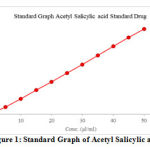 |
Figure 1: Standard Graph of Acetyl Salicylic acid |
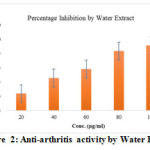 |
Figure 2: Anti-arthritis activity by Water Extract. |
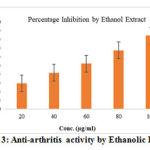 |
Figure 3: Anti-arthritis activity by Ethanolic Extract. |
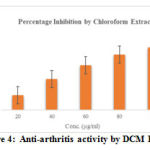 |
Figure 4: Anti-arthritis activity by DCM Extract |
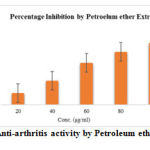 |
Figure 5: Anti-arthritis activity by Petroleum ether Extract |
Discussion
The phytochemical analysis of different extract of Plumbago zeylanica shows the presence of Carbohydrate, Triterpenes and glycosides in the Petroleum ether extract. Carbohydrate, Triterpenes, flavonoids and alkaloids were found in Ethanol extract. The chloroform extract showed the presence of triterpenes, alkaloids and sterols, whereas water extract showed the presence of Carbohydrate and triterpenes.
The Extracts of Plumbago zeylanica were screened for anti-bacterial activity against various bacteria species, and the results indicate that the water extract showed no any activity against the concerned bacterial species. The petroleum ether extract inhibited the growth of all the selected bacteria excepted Bacillus cereus and Klebsiella pneumoniae and the maximum zone of inhibition was found against Pseudomonas aeruginosa. The chloroform extract inhibited the growth of all the microbial species and maximum growth of inhibition was observed against Serratia marsecens. The ethanolic extract of the plant showed marginally less inhibition than the petroleum ether and chloroform extracts, although inhibited the growth of only Staphylococcus aureus, Bacillus cereus, Acinetobacter baumanii, Serratia marsecens, Klebsiella pneumoniae species. These results indicated that the plant Plumbago zeylanica have good antibacterial properties which could be because of the presence of many phytochemicals (Kirtikar KR, 1984, Thakur RS, 1989).
The antifungal Analysis of the plant extracts indicates that the ethanolic extract is most effective against all the selected fungus with maximum zone of in 7mm against the Aspergillus parasiticus. The Petroleum ether extract of the plant was effective against all the selected fungus with the max zone of inhibition of 3mm against Trichoderma rubrum. The chloroform extract shows the max zone of inhibition of 5mm against Aspergillus parasiticus and Trichoderma rubrum. The Aqueous extract shows the minimum zone of inhibition as compared with the other extract and was unveiled to inhibit the growth of Aspergillus parasiticus. The antifungal activities of Plumbago zeylanica could be mentioned due to presence of compounds (Tang Xiao-guang, 2002).
An arthritis or protein denaturation is a process in which proteins lose their tertiary and secondary structure due to external stress or compound, like strong acid or base, concentrated inorganic salt, an organic solvent or heat. All most all the animal proteins lose their biological function when denatured, like enzymes lose their activity, because the substrates can no longer bind to the active site. Protein denaturation is one of the cause of rheumatoid arthritis as elevated. Also in some cases the production of auto antigen may cause denaturation of protein in certain arthritic diseases. The Modulation of electrostatic, hydrogen, hydrophobic and disulphide bonding may cause the denaturation of proteins. This anti-denaturation effect further gets supported by the change in viscosities and it had been reported that the viscosities of protein solutions increase on denaturation. From the result of the present study, it can be stated that all the extracts of Plumbago Zeylanica have the capacity to control the production of auto–antigens so inhibits the denaturation of proteins of both fresh egg albumin and bovine albumin in a dose dependent manner and there effect were compared with the standard drug Acetyl Salicylic acid. Water extract (Fig 2) of Plumbago Zeylanica have pronounced effect against arthritis, followed by ethanolic extract (Fig 3). The chloroform extract (Figure 4) showed less anti-arthritis activity as the IC50 value of about 53.21. Similarly the IC50 value 56.52 of petroleum ether extract showed less response against arthritis (Fig 5). All together the anti-arthritis activity of the concerned plant extracts could be due the presence of phyto-compounds with anti-arthritic activity (Tapiero H, 2002, Folts JD, 2002).
Conclusion
The present study finds out a possible antimicrobial drug of natural source. Of the extracts screened for antibacterial activity mostly were active against most of the bacterial strains except aqueous extract that gave discouraging results and was not found to be active against any of the bacterial strains. So it could be concluded that the moderate antibacterial activity of the different extract have been analysed. The results of antifungal assay of the extracts unexpectedly were not found too well although the inhibition of fungi species was observed. Also the anti-arthritis activity shown by the plant extracts was found very encouraging as almost all types of extracts responded good for the production of auto–antigens so inhibits the denaturation of proteins. The antibacterial, antifungal and anti-arthritis activities can further be enhanced if the phyto-active components responsible for curing such diseases could be determined by GC-MS and NMR analysis, then isolated, purified and applied in proper dosage form.
Acknowledgement
There was no any funding agency for the concerned work, and all the expenditures were carried out by the authors itself, although we are thankful to PMU Saudi Arabia for allowing us to work on the project in reference.
Conflict of Interest
The authors declare no conflict of interest.
References
- Verma Sheetal, and Singh SP. Current and future Status of Herbal Medicines. Veterinary World, 1(11): 347-350 (2012).
- Jeyachandran R, Mahesh A, Cindrella Antibacterial Activity of Plumbagin and Root Extracts of Plumbago zeylanica L. Acta Biologica Cracoviensia Series Botanica, 51(1): 17-22 (2009).
- Sandhya B, Thomas S, Isabel W, Shenbagarathai R. Ethnomedicinal Plants Used By the Valaiyan Community of Piranmalai Hills (Reserved Forest), Tamilnadu, India. – A Pilot Study. J. Trad. CAM 3, (1): 101-114 (2006).
CrossRef - Alok Sharma, Shanker C, Lalit Kumar Tyagi, Mahendra Singh. Herbal Medicine for Market Potential in India: An Overview. Academic Journal of Plant Sciences, 1 (2): 26-36 (2008)
- Perveen Anjum Qaiser. Pollen Flora of Pakistan – xxxix. Plumbaginaceae. j. bot, 36(2): 221-227 (2004).
- Kantha Deivi Arunachalam, Velmurugan P, Balaji Raja Anti-inflammatory and Cytotoxic Effects of Extract from Plumbago zeylanica. African Journal of Microbiology Research, 4(12):1239-1245 (2010).
CrossRef - Dolores Lledo M, Manuel B Crespo, Michael F Fay, Mark W Chase. Molecular Phylogenetics of Limonium and Related Genera (Plumbaginaceae): Biogeographical and Systematic Implications. American Journal of Botany, 92(7):1189-1198 (2005).
- Samant, SS, Dhar U, Palni LMS. Medicinal plants of Indian Himalaya: Diversity, distribution, potential values. Nainital, Gyanodaya Prakashan (1998).
- Chetty K, Mdhava Sivaji K, Rao K Tulsi. Flowering Plants of (Chittor District Andhra Pradesh) India. Student offset printers Tirpati, 185 (2008).
- Farroq Dr S. 555 Medicinal Plants Field & Laboratory Manual. International Book Distributers, Dehradun, 240 (2005).
- Kumar Rajesh. Hepatoprotective Activity of Aerial Parts of Plumbago Zeylanica Linn against Carbon Tetrachloride-Induced Hepatotoxicity in Rats. International Journal of Pharmacy and Pharmaceutical Sciences, 1(l): 171-173 (2009).
- Gopinath S, Muralidharan S, Rajan S, Danaphal SP. Simultaneous Estimation of Plumbagin and Embelin by Reverse Phase-High Performance Liquid Chromatographic method. Der Pharmacia Letter, 1 (1): 135-142 (2009).
- Nile Shivraj H, Khobragade CN. Antioxidant Activity and Flavonoid Derivatives of Plumbago zeylanica. Journal of Natural Products, 3: 130-133 (2010).
- Joshi Shankar Gopal Medicinal Plants. Oxford & IBSH publishing Co. Pvt. Ltd. New Delhi reprint, 313 (2007).
- Sonibare Oluwadayo O, Sojinu Olatunbosun S. Chemical Composition of Leaf Lipids of Angiosperms: Origin of Land Plant- Derived Hydrocarbons in Sediments and Fossil Fuel. European Journal of Scientific Research, 25(2): 192-199 (2009).
- Abera Balcha, Negash Legesse, Kumlehn Jochen. Reproductive Biology in the Medicinal Plant, Plumbago zeylanica African Journal of Biotechnology, 7(19): 3447-3454 (2008).
- Kokate CK, Purohit AP, Gokhke SB. Text Book of Pharmacognosy. 3rd edition, Nirali Prakashan, Pune. 593-597 (2005).
- Mukherjee PK. Quality Control of Herbal Drugs-an Approach to Evaluation of botanicals, 1st edition, New Delhi, Business Horizons Pharmaceuticals publications, 183-197 (2002).
- Khandelwal KR. Practical Pharmacognosy 3rd edition, Nirali Prakashan, Pune. 165 (1996).
- Panikar Ananthanarayan. Panikars text Book of Microbiology. 7th edition, reprint published by orient Longman Pvt. Ltd. Chennai, (2007).
- Pelczar Michael J. Microbiology. 5th edition, 34th reprint published by Tata Mc Graw-Hill Publishing Company Ltd. New Delhi (2007).
- Aneja KR. Experiments in Microbiology, Plant Pathology & Biotechnology. 4th edition reprint, Published by New Age International Publisher Pvt. Ltd. New Delhi.15: 535-546 (2009).
- Deshpande V, Jadhav VM, Kadam VJ. In-vitro anti arthritic activity of Abutilon indicum (Linn.) Sweet. Journal of Pharm. Res, 2(4): 644-645 (2009).
- Amin Mir, Tabassum Rashid, Misbah Tabassum, MMS Jassal. Treatment of Bodily Disarrays like Inflammation and Arthritis by Various Biological Extracts. Indo Am. J. P. Sci, 4(10): (2017).
- Kirtikar KR, Basu BD. Indian Medicinal Plants, Volumes I & II. Allahabad, India (1984).
- Thakur RS, Puri HS, Husain A. Major Medicinal Plants of India. Lucknow, India: Central Institute of Medicinal and Aromatic Plants, (1989).
- Tang Xiao-guang, Wang Chao, MA Xiao-chi. Chemical Constituents of the Aerial Parts from Plumbago zeylanica.Journal of Chinese Medicinal Materials, 39 (7): 1541-1544 (2016).
- Tapiero H, Tew KD, Ba GN, and Mathe G. Polyphenols: do they play a role in the prevention of human pathologies? Biomed Pharmacother, 56: 200–207 (2002).
CrossRef - Folts JD. Potential health benefits from the flavonoids in grape products on vascular disease. Exp. Med Biol, 505: 95–111 (2002).
CrossRef








